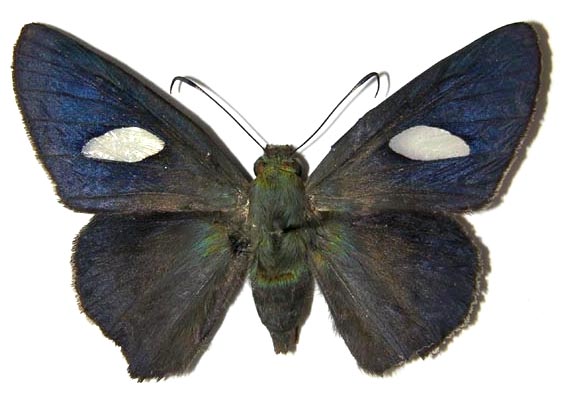Butterfly Mimicry
Porphyrogenes peterwegei Moth
Costa Rica
From the researcher's perspective...
You are a 12-gram, insectivorous, tropical rainforest bird, foraging in shady, tangled, dappled, rustling foliage where edible caterpillars and other insects are likely to shelter.
Abruptly an eye appears, 1–5 centimeters from your bill. The eye or a portion of it is half seen, obstructed, shadowed, partly out of focus, more or less round, multicolored, and perhaps moving. If you pause a millisecond to ask whether that eye belongs to acceptable prey or to a predator, you are likely to be—and it takes only once—someone's breakfast.
In the first glance at the female of Porphyrogenes Burns01, the reaction is "well, not all Area de Conservación Guanacaste (ACG) rain forest Hesperiidae are mimics, since there is nothing else known that 'looks' like this". Hmm. Think again. Yes, as the lepidopterologist tends to see a butterfly, looking for a quite exact match before "mimicry" crosses the mind; there is nothing else like Porphyrogenes peterwegei BURNS01. But how does this butterfly appear when buzzing around in the dark understory of the forest, and/or in the dusk when it most likely flies (no one has knowingly seen this butterfly in flight in ACG, despite more than 40 having been reared by the caterpillar inventory, mostly feeding on Machaerium seemannii)?
There are tens of species of ACG rain forest hesperiids that are approximately the same medium-large size, dark brown to almost black, and blessed with a white band or archipelago of white patches in the middle of the forewing (Nascus spp., Celaenorrhinus spp., Telemiades spp., Narcosius spp., Ridens spp., etc.). Many, if not all, are denizens of the dusk and the shady forest understory, and all give the same impression of a dark blur with a white marker. All are fast as lightning, very alert to an approaching shape or motion, and all radiate the message "I am too fast, don't bother to try to catch me". Yes, each has a large enough body to make a plump meal for the pursuing insectivorous bird, but even that enticement is unlikely to elicit a pursuit if it does not pay dividends.
The male of Porphyrogenes peterwegei BURNS01 is quite a different animal, with its wings free of markings uniform brown with even a slight purplish sheen. But again, as in so many other ACG species of butterflies, it is also easily visualized as a member of a different complex of mimetic hesperiids. But the male revealed the tip of an iceberg.
This species was unknown to science before the ACG caterpillar inventory. But with the male in hand, it was an obvious idea to search the medium-large uniformly brown hesperiids accumulated at INBio from the many nights of moth collecting at light traps by INBio parataxonomists throughout Costa Rica. Indeed, among them were four male Porphyrogenes that to any bird or collector looked exactly like Porphyrogenes peterwegei BURNS01. But John Burns dissected them and found at least four more species of Porphyrogenes – yes, one species per specimen - none known before from Costa Rica. This of course means four more species of females as well, and even though they are unknown, it is a fair guess that some may be quite similar to the female shown here. South America, which according to Bernard Hermier and his study of Porphyrogenes as a whole contains at least 15 species of Porphyrogenes, has some females that – though known from only a very few specimens – are quite similar to those of Porphyrogenes peterwegei BURNS01.
It will not have escaped the observer that many of the moths and butterflies are undescribed, as is Porphyrogenes peterwegei BURNS01. But the taxonomic process is in motion, and perhaps it will be blessed with its anticipated patronym, being baptized in honor of Peter Wege of Grand Rapids, Michigan, who has so strongly supported the purchase and conservation of the very forest in which Porphyrogenes peterwegei BURNS01 maintains a healthy breeding population, and will do so into perpetuity thanks to Peter's help.
Daniel H. Janzen, Winnie Hallwachs, and John Burns
DNA Barcode of Porphyrogenes peterwegei
Accessed from Barcode of Life Data Systems
MHMXW038-09 | 08-SRNP-65453 | Porphyrogenes peterwegei | COI-5P
AACCTTATATTTTATTTTTGGAATCTGAGCAGGAATAGTAGGAACTTCTCTAAGATTACTAATTCGAACTGAATT AGGAACCCCCGGATCTTTAATTGGAGATGACCAAATTTATAATACTATTGTTACAGCTCATGCTTTTATTATAAT TTTCTTTATAGTTATACCTATTATAATTGGAGGTTTTGGAAATTGACTAGTTCCTTTAATACTGGGAGCTCCTGA TATAGCATTCCCCCGAATAAATAATATAAGATTTTGATTATTACCCCCTTCTTTAACTCTTTTAATTTCAAGAAG AATTGTAGAAAATGGTGCAGGTACAGGTTGAACTGTATACCCCCCTTTATCATCAAATATTGCTCATCAAGGATC TTCTGTTGATTTAGCAATCTTTTCTCTACATCTTGCAGGTATTTCTTCAATTTTAGGAGCTATTAATTTTATTAC TACAATTATTAATATACGAATTAACAATTTATCTTTTGACCAAATACCTCTATTTGTTTGAGCAGTAGGAATTAC AGCTTTATTATTATTATTATCATTACCAGTTTTAGCTGGTGCAATTACTATACTTTTAACTGATCGAAATTTAAA TACTTCATTTTTTGATCCTGCTGGAGGAGGTGATCCTATTTTATACCAACACTTATTT


